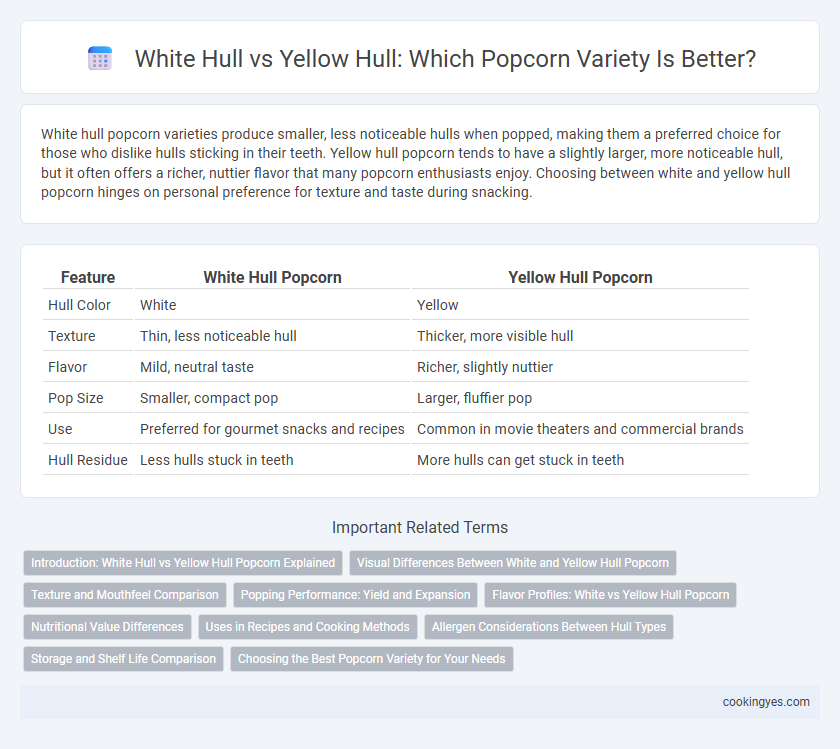White hull popcorn varieties produce smaller, less noticeable hulls when popped, making them a preferred choice for those who dislike hulls sticking in their teeth. Yellow hull popcorn tends to have a slightly larger, more noticeable hull, but it often offers a richer, nuttier flavor that many popcorn enthusiasts enjoy. Choosing between white and yellow hull popcorn hinges on personal preference for texture and taste during snacking.
Table of Comparison
| Feature | White Hull Popcorn | Yellow Hull Popcorn |
|---|---|---|
| Hull Color | White | Yellow |
| Texture | Thin, less noticeable hull | Thicker, more visible hull |
| Flavor | Mild, neutral taste | Richer, slightly nuttier |
| Pop Size | Smaller, compact pop | Larger, fluffier pop |
| Use | Preferred for gourmet snacks and recipes | Common in movie theaters and commercial brands |
| Hull Residue | Less hulls stuck in teeth | More hulls can get stuck in teeth |
Introduction: White Hull vs Yellow Hull Popcorn Explained
White hull popcorn features thinner, softer hulls that create a more tender eating experience, while yellow hull popcorn has thicker, tougher hulls offering extra crunch. The color difference stems from the pericarp pigmentation, influencing texture and taste preferences among consumers. Popular white popcorn varieties include White Mushroom and White Butterfly, whereas yellow popcorn typically involves Orange Mushroom and Yellow Butterfly types.
Visual Differences Between White and Yellow Hull Popcorn
White hull popcorn features a thinner, lighter-colored outer shell that often results in a more subtle, less noticeable hull after popping. Yellow hull popcorn has a thicker, more robust outer shell with a deeper yellow hue, making the hull more visible and sometimes slightly tougher when eaten. These visual differences influence texture perception and consumer preference in snack appearance.
Texture and Mouthfeel Comparison
White hull popcorn features a thinner, more delicate hull that results in a tender, less noticeable crunch, creating a smoother mouthfeel that is preferred for easy eating. Yellow hull popcorn has a thicker, sturdier hull which offers a more pronounced, crisp texture and a heartier crunch, providing a satisfying bite. The hull thickness directly influences the popping performance and consumer experience, making white hulls ideal for those seeking a softer texture and yellow hulls favored by those who enjoy a robust mouthfeel.
Popping Performance: Yield and Expansion
White hull popcorn typically offers higher popping expansion with thinner, less noticeable hulls, enhancing the eating experience by reducing kernel debris. Yellow hull popcorn yields a slightly greater popped volume per kernel due to its larger size but produces thicker hulls that may affect texture. Both varieties provide excellent popping performance, with white hull favored for tenderness and yellow hull preferred for maximizing overall popped yield.
Flavor Profiles: White vs Yellow Hull Popcorn
White hull popcorn offers a tender, crisp texture with a subtle, delicate flavor that enhances sweet seasonings, making it ideal for gourmet varieties. Yellow hull popcorn delivers a slightly nuttier, richer taste with a robust crunch, favored for traditional buttered and savory toppings. Flavor profiles between white and yellow hull popcorn distinctly influence consumer preferences based on texture and seasoning compatibility.
Nutritional Value Differences
White hull popcorn kernels generally have a thinner, more tender hull compared to the thicker, tougher hull of yellow hull varieties, which can affect fiber content and digestibility. Nutritionally, yellow hull popcorn tends to contain slightly higher amounts of antioxidants such as carotenoids, due to the presence of yellow pigments, while white hull popcorn may offer a milder flavor with marginally lower fiber. Both varieties provide similar levels of calories, protein, and carbohydrates, making them comparable in basic macronutrient content but differing subtly in fiber and antioxidant profiles.
Uses in Recipes and Cooking Methods
White hull popcorn produces smaller, tender kernels ideal for recipes requiring delicate texture, such as stovetop popping and caramel coatings. Yellow hull popcorn offers larger, fluffier kernels suited for theater-style popping and savory seasoning blends, enhancing texture in crunchy snacks. Both varieties adapt well to different cooking methods, but white hull's subtle flavor excels in sweet applications, while yellow hull holds up better in bold, spicy recipes.
Allergen Considerations Between Hull Types
White hull popcorn varieties typically have thinner, more fragile hulls, reducing the likelihood of sharp hull fragments causing oral irritation or allergic reactions in sensitive individuals. Yellow hull popcorn, known for its thicker, sturdier hulls, may pose a higher risk of discomfort for those with hull-related sensitivities or mild allergies. Selecting white hull popcorn can be a safer option for consumers concerned with allergen exposure linked to popcorn hulls.
Storage and Shelf Life Comparison
White hull popcorn varieties typically have thinner hulls, resulting in a more tender texture but slightly shorter shelf life due to increased susceptibility to moisture absorption. Yellow hull popcorn maintains better durability during storage, as its thicker hull provides enhanced protection against humidity and physical damage, extending its freshness. Proper storage in airtight containers at low humidity conditions maximizes shelf life for both varieties, but yellow hull popcorn generally offers superior longevity.
Choosing the Best Popcorn Variety for Your Needs
White hull popcorn offers a thinner, more tender hull that is less noticeable when popped, making it ideal for those who prefer a smoother texture and easier eating experience. Yellow hull popcorn features a thicker, more robust hull that provides a crunchier bite and often yields larger, fluffier popped kernels, favored for its classic popcorn flavor and visual appeal. Selecting between white and yellow hull varieties depends on personal preference for texture, flavor intensity, and kernel size, ensuring the best popcorn variety aligns with your snacking needs.
White hull vs Yellow hull for popcorn variety Infographic

 cookingyes.com
cookingyes.com